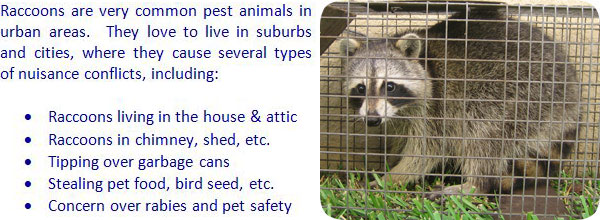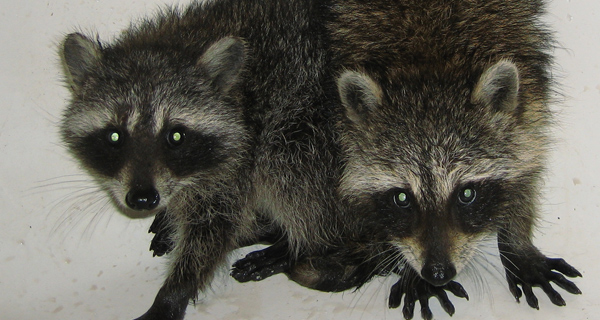- info@wildlifeanimalcontrol.com
Call us for help in your town
Wildlife Control Education
How to Catch a Raccoon

Need raccoon removal in your hometown? We service over 500 USA locations! Click here to hire us in your town and check prices - updated for year 2020.
Raccoons can be over two feet long and weigh up to 33 lbs. They are opportunistic omnivores. They will eat almost anything they can find including meat, vegetables, white bread, and cat food, but they absolutely love anything sweet. They will eat just about everything people like.
When raccoons start digging up your yard looking for bugs or getting into your trashcans at night, they can cause a huge mess. Your gardens may also be a prime target. Other times, females will nest inside or under your home to give birth to and raise their young.
No-kill Traps
Catching a raccoon can be very difficult to do. They are intelligent animals. If they get in and out of a trap without being caught, they will remember what happened and you will have to change your tactics. Using a no-kill, or live cage, trap is the best way to humanely catch raccoons.
What to Look for in a Trap
Havahart traps are the most commonly no-kill traps purchased in the United States. There are specific traps for raccoons in order to account for the animals’ size. They are at least 32 inches long and about a foot high and wide.
You need to make sure the trap is of a correct size to safely keep the raccoon inside. If it is too small, they may not get their body all the way in and will either escape or become caught in the door. This can cause a lot of pain to the raccoon and you want to avoid that at all costs.
What Bait to use
Raccoons enjoy eating almost anything. If a human likes it, so will a raccoon in most cases. You need to be aware of what bait you choose. For instance, if you choose meat of some sort you may actually catch a stray cat, a neighborhood cat, or an opossum.
Read more about What Bait To Use For Raccoon Traps here.
Time and time again, professional trappers rely on marshmallows. They say it is one of the best things to bait with. They are small and look like the eggs of other animals, and they are sweet and appeal to the raccoons’ love of sugar.

How to set a Trap
Find fresh tracks to see where the raccoons walk most often. Set the trap near their trail, but away from anything they may be able to reach with their arms once in the cage, about 6 inches.
Make sure the trap is on flat ground. The animal will not go in if the cage wobbles or makes any noise. Line the inside with leaves to make the cage more enticing.
Set the trap in the shade and check it at least twice a day. Do not leave the trap in full sun. They can become dehydrated and overheat, and die a very painful death. You should also place it in the shade in case you trap a neighborhood cat. You do not want to kill your neighbors’ pet. The neighbor just might sue you.
Disguise your trap and put the bait down in a trail leading up to the trap’s door. Keep the trail going but do not stop at the trip pan. The bait should make a trail all the way to the back of the cage. Once all of these things are done, you need to wait patiently.
If you have raccoons living in the attic, you can't just put a cage trap on the ground, because there might be a nest of baby raccoons in the attic. They must be removed by hand.
After you catch the Raccoon
If you have successfully trapped a raccoon, put a blanket or other cover over the cage before you pick it up. Do not stick your fingers in the cage and hold the trap away from yourself. Remember raccoons can carry rabies.
Look at the raccoon and see if it has nipples. If it does, you should release it right away. It means it is a female and she has babies. If you do not, they will starve to death. They cannot find food on their own.
Relocate a raccoon without babies at least ten miles away from your home and it will not come back.
Keep in mind that trapping is illegal in many states. Before you start trapping, call your local animal control office. If it is illegal in your state, hire a professional to take care of the problem for you.
Catching raccoons in traps is not very easy, but once you are successful in completing the task you realize that only half of the job has been done because now you have to decide that what you will have to do with the trapped animal. Many people don’t like the idea of capturing the animal alive and use traps which can kill the animal, but to be honest it is not humane because a number of traps and methods, which kill the raccoon subject it to great pain and discomfort so it is suggested that you should only consider killing the animal when no other option is left. However, important point that should be mentioned here is that prior to taking any step you need to consider that what local laws say about the matter because in any case violation of legal standards is never proposed so you have to be careful. Now after capturing the animal you are left with two options you can either relocate it to a safe place or can kill it in a manner which bring least level of pain and discomfort for the raccoon. In any case we strongly suggest that you should stay away from violating any kind of law because this can cause great trouble.

Relocating the animal
Relocation is the best and most understandable choice, which people make in this regard because in this manner no harm comes to the animal and you also resolve the problem. However, for making this strategy successful you need to plan things in the right way because mistakes can ruin everything. It is important that you should release the animal at a distance of approximately 10 miles from your property because in this way it will not be able to find way back. It is also important that you should release the animal at some safe place where it can find decent supply of food and can live without any external threat without imposing problems for others. Mother raccoon should always be transferred with her babies because young ones can’t survive without their mother.
Killing the animal
Killing is the other option, which you have, but as described above it is not the best way to adopt. However, if you don’t have any other choice, then again we will suggest that try to find a strategy that can kill the animal without bringing much pain to it. There are a number of paths that can be adopted you can either shoot the animal or kill it by giving poison, but poisoning is never an ideal approach because it subjects the animal to great pain and kills it slowly. From the above discussion it is evident that relocating the animal is the best thing to do after capturing the animal.
More in-detail how-to raccoon removal articles:
Information about raccoon trapping - analysis and methods for how to trap.
Information about how to kill a raccoon - with poison or other methods.
Information about how to keep raccoons away - prevention techniques.
Information about raccoon repellent - analysis of types and effectiveness.
This site is intended to provide rinformation about how to catch raccoons, so that you can make an informed decision
if you need to deal with a raccoon problem. This site provides many raccoon control articles and strategies, if
you wish to attempt to solve the problem yourself. If you are unable to do so, which is likely with many
cases of raccoon removal, please go to the home page and click the USA map, where I have wildlife removal experts
listed in over 500 cites and towns, who can properly help you with your nuisance raccoon.
Click here to
read more about how to get rid of raccoons.

















